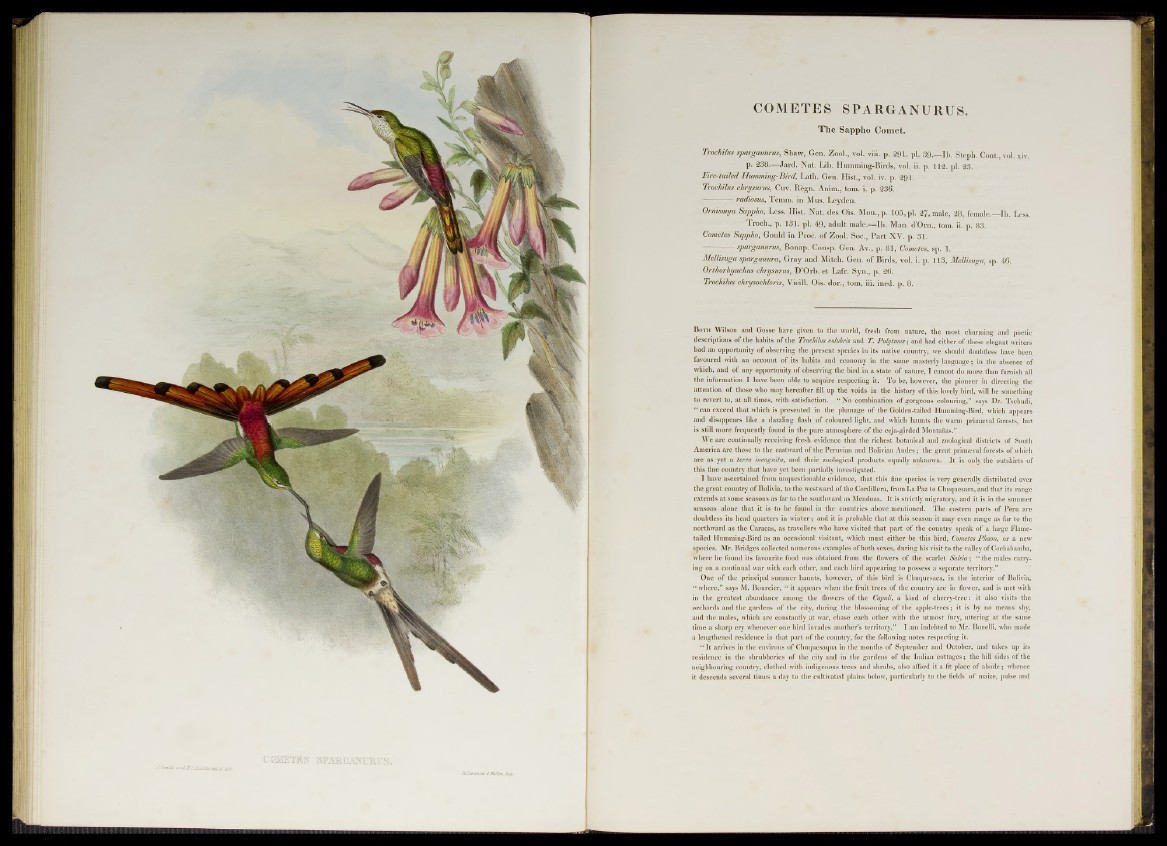
€ ©METES SPARGANÜRÜB.
COMETES SPARGANURUS.
The Sappho Comet.
Trochi/us sparganurus, Shaw, Gen. Zool., vol. viii. p. 291. pi. 39.—Ib. Steph. Cont., vol. xiv.
p. 238.—Jard. Nat. Lib. Humming-Birds, vol. ii. p. 112. pi. 23.
Tire-tailed Humming-Bird, Lath. Gen. Hist., vol. iv. p. 291.
Trochilus chrysurus, Cuv. R^gn. Anim., tom. i. p. 236.
/ radiosus, Temm. in Mus. Leyden.
Ornismya Sappho, Less. Hist. Nat. des Ois. Mou.,p. 105, pi. 27, male, 28, female.—Ib. Less.
Troch., p. 131. pi. 49, adult male.— Ib. M an. d’Orn., tom. ii. p. 83.
Cometes Sappho, Gould in Proc. o f Zool. Soc., Part X V. p. 31.
— sparganurus, Bonap. Consp. Gen. Av., p. 81, Cometes, sp. 1.
Mellisuga sparganura, Gray and Mitch. Gen. o f Birds, vol. i. p. 113, Mellisuga, sp. 46.
Orthorhynchus chrysurus, D ’Orb. et Lafr. Syn., p. 26.
Trochilus chrysochloris, Vieill. Ois. dor., tom. iii. ined. p. 8.
B o t h Wilson and Gosse have given to the world, fresh from nature, the most charming and noetic
descriptions of the habits of the Trochilus colubris and T. Polytmus; and had either of these elegant writers
had an opportunity of observing the present species in its native country, we should doubtless have been
favoured with an account of its habits and economy in the same masterly language; in the absence of
which, and of any opportunity of observing the bird in a state of nature, I cannot do more than furnish all
the information I have been able to acquire respecting it. To be, however, the pioneer in directing the
attention of those who may hereafter fill up the voids in the- history of this lovely bird, will be something
to revert to, at all times, with satisfaction. “ No combination of gorgeous colouring,” says Dr. Tschudi,
“ can exceed that which is presented in the plumage of the Golden-tailed Humming-Bird, which appears
and disappears like a dazzling flash of coloured light, and which haunts the warm primaeval forests, but
is still more frequently found in the pure atmosphere of the ceja-girded Montanas.”
We are continually receiving fresh evidence that the richest botanical and zoological districts of South
America are those to the eastward of the Peruvian and Bolivian Andes; the great primaeval forests of which
are as yet a terra incognita, and their zoological products equally unknown. It is only the outskirts of
this fine country that have yet been partially investigated.
I have ascertained from unquestionable evidence, that this fine species is very generally distributed over
the great country of Bolivia, to the westward of the Cordillera, from La Paz to Chuquesaca, and that its range
extends at some seasons as far to the southward as Mendoza. It is strictly migratory, and it is in the summer
seasons alone that it is to be found in the countries above mentioned. The eastern parts of Peru are
doubtless its head quarters in winter; and it is probable that at this season it may even range as far to the
northward as the Caracas, as travellers who have visited that part of the country speak of a large Flametailed
Humming-Bird as an occasional visitant, which must either be this bird, Cometes Phaon, or a new
species. Mr. Bridges collected numerous examples of both sexes, during his visit to the valley of Cochabamba,
where he found its favourite food was obtained from the flowers of the scarlet Salvia; “ the males carrying
on a continual war with each other, and each bird appearing to possess a separate territory.”
One of the principal summer haunts, however, of this bird is Chuquesaca, in the interior of Bolivia,
“ where,” says M. Bourcier, “ it appears when the fruit trees of the country are in flower, and is met with
in the greatest abundance among the flowers of the Capuli, a kind of cherry-tree: it also visits the
orchards and the gardens of the city, during the blossoming of the apple-trees; it is by no means shy,
and the males, which are constantly at war, chase each other with the utmost fury, uttering at the same
time a sharp cry whenever one bird invades another’s territory.” I am indebted to Mr. Bonelli, who made
a lengthened residence in that part of the country, for the following notes respecting it.
“ It arrives in the environs of Chuquesaqua in the months of September and October, and takes up its
residence in the shrubberies of the city and in the gardens of the Indian cottages; the hill sides of the
neighbouring country, clothed with indigenous trees and shrubs, also afford it a fit place of abode; whence
it descends several times a day to the cultivated plains below, particularly to the fields of maize, pulse and